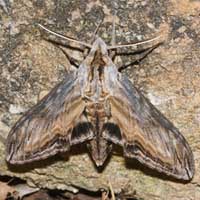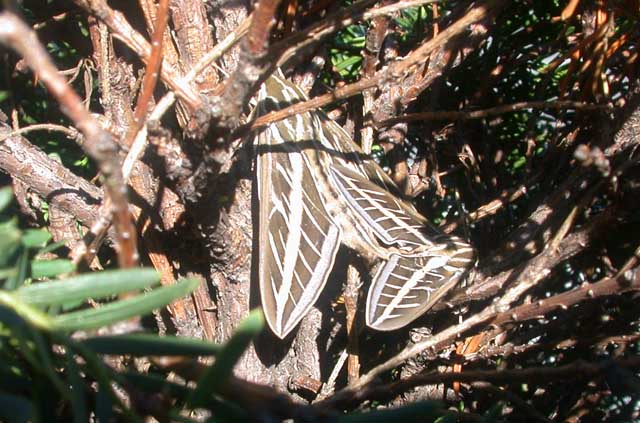Sphinginae subfamily
Sphingini tribe:
 |
Ceratomia amyntor USGS,
the Elm Sphinx or Four-horned Sphinx.
The fw upperside is brown with dark brown and white markings including a white costal area near wing base,
dark streaks along veins, and a white spot in cell. The hw upperside is light brown and has dark brown band along outer margin.
Larvae feed on Elm (Ulmus), birch (Betula), basswood (Tilia), and
cherry (Prunus).
|
 |
The upperside of the forewing is yellowish brown with no white markings, but there are indistinct black lines and dashes. The cell
spot is gray with a black outline and the upperside of the hindwing is yellowish brown with obscure lines. Catalpa is the larval host.
|
 |
Ceratomia undulosa
WO, the Waved
Sphinx.
The fw upperside is pale brownish gray with wavy black and white lines and a black-outlined white cell spot.
The upperside of the hindwing is gray with diffuse darker bands.
Some individuals are very dark, almost black, and others are light yellowish brown.
|
 |
The upperside of the forewing is dark brown with a dusting of white scales. Some moths have patches of reddish or yellowish brown on the wings.
|
 |
The upperside of the forewing is gray with heavy black bands. The upperside of the hindwing is brownish gray with no markings.
The underside is rather plain.
|
 |
Lapara coniferarum
WO, the Southern Pine Sphinx.
The fw upperside is gray with two (sometimes one or three) black dashes near wing center; other markings are usually diffuse. The
hw upperside is uniform brown-gray.
This species does not have the more sharply contrasting black markings of a fresh Lapara bombycoides.
|
 |
Lintneria eremitus WO, the
Hermit Sphinx.
Fw upperside: gray-brown with wavy lines, black dashes, one or two small white spots near center of costa.
Hw upperside: black with two white bands, triangular black patch at base. Note golden hair on thorax.
Larval hosts: various species of beebalm (Monarda), mints (Mentha), bugleweed (Lycopis),
sage (Salvia).
|
 |
The upperside of forewing is gray to grayish brown with a black line running from the middle of the costa to the middle of the outer margin; the line may
be broken near the margin. There is a splash of brown around the cell spot. The upperside of the hindwing is mostly black, with gray at the lower margin.
|
 |
Manduca quinquemaculatus
WO,
the Five-spotted Hawkmoth.
Abdomen usually has five but sometimes six pairs of yellow bands. Fw upperside: blurry brown and gray. Hw upperside:
banded with brown and white, two well-separated median zigzag bands. Fw fringes: grayish, not distinctly spotted with white.
|
 |
The abdomen of the adult moth has three pairs of yellow spots. The upperside of the forewing is yellowish brown to deep chocolate brown with a
dusting of white scales and zigzagged black and white lines.
|
 |
Manduca sexta
WO, Carolina Sphinx.
Abdomen usually has six pairs of yellow bands, broken across back. Sixth set of markings is quite small.
Fw upperside: indistinct black, brown, and white markings.
Hw upperside: banded with black and white, two black zigzag median lines very close together with hardly any white showing between them.
Fringes: spotted with white.
|
 | The upperside of the forewing is gray with indistinct black and
white markings. There is a series of black dashes
from the base to the tip, and a small white cell spot.
|
 |
Sphinx chersis WO,
the Northern Ash Sphinx or Great Ash Sphinx
Fw upperside: soft dark gray to blue-gray with a series of black dashes, one of which reaches the wing tip.
Hw upperside: black with blurry pale gray bands. Larval hosts are ash,
lilac, privet, cherry, and quaking aspen.
|
 |
Sphinx drupiferarum
WO, the
Wild Cherry Sphinx
FW is dull slate grey with considerable light grey scaling in a broad band along the costa about 3/4 of distance from body toward
the apex. Median lines are black and thin. Wavy, diffuse dark subterminal line, inwardly bordered by white. Whitish bar in terminal area,
paralleling outer margin.
|
 |
The outer margins of the forewings are slightly concave in the male, but not in the female. The costal half of the forewings are grey, but the posterior
portion is a distinctive warm yellowish-brown; the boundary between these
two areas is marked with a series of dark diagonal streaks. The hindwings are black with a brown basal patch, a median band and margin. |
 |
The upperside of the forewing ranges from brown with black borders through brownish gray with paler borders to pale gray with no borders.
Dashes, submarginal line, and cell spot are usually weak.
|
 |
The lower forewings are predominantly brownish-yellow with a fairly wide dark bar along the inner margin. At rest the wings hug the body, giving the moth a long slender look.
|
Smerinthini Tribe:
 |
Adults highly variable; sometimes wings of an individual may be all one color or may have several colors, ranging from pale to dark brown, and may have a
white or pink tinge. Patterns range from faint to pronounced.
See the file for the female; she is different. |
 |
Pachysphinx modesta
USGS,
the Modest Sphinx or Poplar Sphinx
This moth has a large, heavy body, and females can be remarkably plump. Larvae are fond
of poplars and
willows.
|
 |
This appears to be an uncommon species. Look for a relatively straight forewing outer margin.
|
 |
Named for the dull grey-blue spot (minus dark pupil) in the hindwing.
The outer margin of the forewing is quite wavy. There is a dark cell spot and a dark oblique line mid wing from the costa almost to the inner margin.
Basic ground colour is pinkish brown.
At rest the lower wings are almost completely hidden.
|
 |
Named for the small eye-spot in the hindwing. The apex is produced and truncated, slightly concave between the costa and next wing vein, followed
by definite concave region (next four wing veins) to lower 3/4 of wing.
|
 |
Smerinthus jamaicensis
USGS,
the Twin-spotted Sphinx.
Smerinthus jamaicensis closely resembles Smerinthus cerisyi, but jamaicensis is much smaller with larger blue patches on more vibrant and deeper purple in the lower wings.
Also note the complete (i.e. outer margin to outer margin) off-white arc just below the forewing apex. |
Macroglossinae subfamily
Dilophonotini tribe:
See Hemaris comparison to help distinguish
the next three species.
 |
Hemaris thysbe
WO, the Hummingbird Clearwing
It is not difficult to see why many gardeners would mistake an Hemaris thysbe moth for a small hummingbird as it hovers, sipping nectar from flowers
through a long feeding tube.
|
 |
Hemaris diffinis
WO, the
Snowberry Clearwing or Bumblebee Moth. Very variable species, but almost always the abdomen sports contrasting black and yellow hairs, the ventral
surface being quite black. The legs also tend
to be quite dark and there is a black mask running across the eye and along the sides of the thorax.
|
 |
Hemaris gracilis WO, the
Slender Clearwing or Graceful Clearwing.
Distinguished from similar species by pair of red-brown bands on sides of thorax, which varies from green to yellow-green dorsally and sometimes brown
with white underneath. Red abdomen.
Wings transparent with reddish brown borders. Outer edge of fw transparent area is even and forewing cell has a median row of scales.
Legs: dorsally red.
|
Philampelini tribe:
 |
The forewing is light grey and brown with many lines, and there are dark patches near the middle of the inner margin, near the apex and near the
anal angle. The entire basal area of the hindwing is pink.
|
 |
Eumorpha pandorus
WO, the Pandorus Sphinx.
Upperside: light brown with shades of olive green to green. Fw: pink streaks along vein ends and near inner margin, and dark squarish mark at
middle of inner margin. Area from
base to squarish mark is dark green. Underside usually is yellow-green, but sometimes is pale brown. |
Macroglossini tribe:
 |
This day flier is widely distributed. If you have Virginia Creeper, you
probably have the Nessus Sphinx. It is not officially reported from
Hudson.
Two bright, distinct, narrow yellow
bands are often visible on the abdomen.
|
 |
They are common in New Jersey and common
here on Prince Edward Island.
You will often see this species listed as Darapsa pholus,
especially in older literature. The lower wings of this hawkmoth are a solid brownish-orange, matching the body colour.
|
 |
Darapsa myron
WO, the Virginia Creeper Sphinx or the Grapevine Sphinx. Fw upperside is dark brown to pale yellowish gray, with an olive tint
(often quite green).
On the costal margin there is a dark rectangular patch, although this may be reduced or absent. The upperside of the hindwing is pale orange.
|
 |
Darapsa versicolor
WO,
the Hydrangea Sphinx.
If you have hydrangea growing near a stream, then you may have the
Hydrangea Sphinx. Fw upperside: often greenish brown with curved dark lines and pinkish-white patches.
Hw upperside: pale yellow to reddish brown with white along costal margin, greenish brown along outer margin,
and white shaded with greenish brown on inner margin.
|
 |
Deidamia inscriptum
WO,
the Lettered Sphinx.
The moth's outer margin of the forewing is deeply scalloped.
The upperside is light brown with dark brown markings.
There is a small black and white spot near the tip.
The upperside of the hindwing is orange-brown with a dark brown outer margin and median line.
Grape (Vitis), ampelopsis (Ampelopsis), and Virginia creeper (Parthenocissus) all serve as larval hosts.
|
 |
Hyles lineata
TV, the White-lined Sphinx
The forewing upperside is dark olive brown with paler brown along the costa and outer margin, a narrow tan band running from the wing tip to the base, and white streaks along the veins.
The hindwing upperside is black with a reddish pink median band.
|
Hyles lineata, September 3, 2010, courtesy of Tom Venturini.
 |
Adults are said to mimic bumblebees and make a buzzing sound when feeding. The wing margins are scalloped. The upperside of the forewing is dark brown with light brown bands and markings.
The upperside of the hindwing is yellow with a wide black outer margin.
|
 |
Xylophanes tersa WO, possible migrant,
the Tersa Sphinx
The upperside of the forewing is pale brown with lavender-gray at the base and has dark brown lengthwise lines throughout.
The upperside of the hindwing is dark brown with a band of whitish, wedge-shaped marks.
|
|
|

